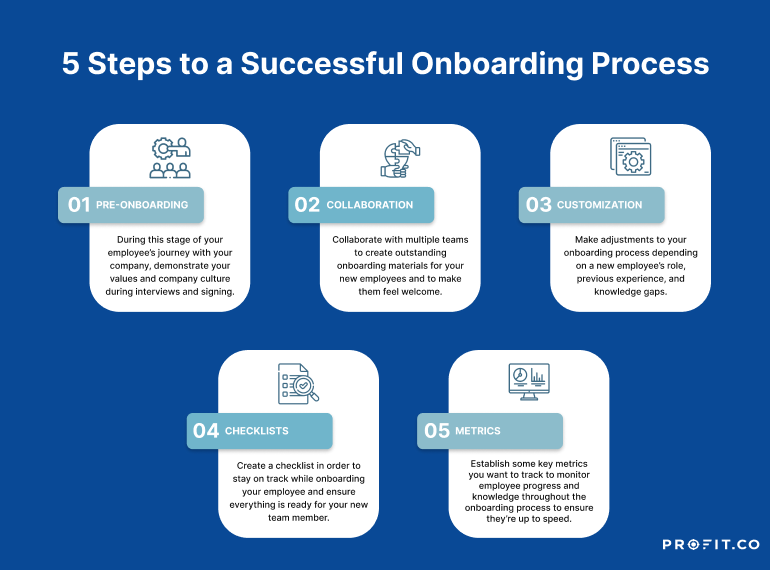Key Takeaways
- Employee onboarding is the best way to set up your new hire for success in your organization.
- Onboarding is different from orientation in terms of duration, content, and objectives.
- A successful onboarding process involves pre-onboarding, collaboration, and metrics to measure your progress.
- The 5 Cs of employee onboarding help integrate your new hire effectively into your organization.
Introduction to onboarding
Employee onboarding is a crucial part of human resources management. It bridges the gap between a new team member and their role in an organization. In the post-pandemic workplace, your onboarding process has to be adaptable to bring on a new team from remote locations.
But first, let’s define what onboarding is and how it differs from employee orientation.
Onboarding Process Defined
According to the Society for Human Resource Management (SHRM), employee onboarding is the process by which newly hired employees are introduced to a company’s culture, mission and vision.
An onboarding process can take anywhere from a few days to weeks and months. A high-quality onboarding program is a great foundation for the new hire’s success in the business, contributing to the overall business success.
Unfortunately, managers fall short with their onboarding process. A 2019 Gallup study showed that only 12% of new employees felt that their employers did a great job at onboarding. This results in a high turnover rate, with new hires quitting their positions within the first year and poor engagement in the remaining employees.
One reason for poor onboarding is that it’s often confused with employee orientation.
Onboarding versus Orientation
To be clear, employee orientation is a boardroom-style event that introduces a new hire to your organization through presentations, paperwork, video conferences, and Q&A sessions. Orientation takes place within the first couple of days after a new team member’s arrival. As you’ll see below, onboarding is a much more comprehensive process. Here are the five key steps to a successful employee onboarding process.
5 Steps to a Successful Onboarding Process

1. Pre-Onboarding
Pre-onboarding includes everything from your job vacancy advertisements to signing the contract. At every stage of the recruitment process, a company has numerous opportunities to show its values and culture. At every touchpoint with your prospective employee, demonstrate why your organization is the best place to work.
2. Collaboration
Work with all departments and teams to create the best possible content for your onboarding process. This means building a great presentation and impressive orientation materials.
Everyone in the organization should also play a role in welcoming the new hire. Be ready to listen and answer any questions your new hire would have. Otherwise, your new hire will feel intimidated, lonely, and disengaged.
3. Customization
New employees are not all on equal footing; each has a different learning and communication style. Your onboarding process should accommodate these variations. For example, give your employees ample time to absorb new content and use a flexible feedback system to communicate throughout the process.
4. Checklists
An onboarding checklist is an easy, effective tool to help you stay on track with the onboarding process. It includes every task you need to do to prepare for your new employee. The most common duties on an onboarding checklist include creating a desk space, setting up email accounts, procuring equipment and devices, and preparing the employee handbook.
5. Metrics
Once your new hire begins the onboarding process, use clear metrics to measure their progress. For example, a scoring or rating system can track when new members complete a software demo.
You can also use simple questions to check whether they read and understood the employee handbook or company policies. Recognize the new employee’s achievements with personalized notes and other acknowledgment forms.
Best Practices for a Great Employee Onboarding Process
Follow these simple best practices to have a successful employee onboarding process every time.
- Communicate your organizational culture right from your company website and social pages
- Build online profiles for the key team members that the new hire will meet during onboarding
- Publish your organization’s policies for the sake of transparency. This way, your new hire will know about working hours, remote work requirements, vacations and leave days, etc.
- Send an official letter outlining the new hire’s role, a company-wide announcement to welcome the new team member, and an office tour plus an information kit to get them started.
- A company email account and access passwords should be available for the new hire by reporting day.
FAQ
What is meant by the Onboarding Process?
Onboarding process means the activities that welcome a new employee into an organization. These include administrative tasks like acquiring new desks and equipment, and regular check-ins with the new employees to monitor their progress.
What are the 4 Phases of Onboarding?
The 4 phases of onboarding are pre-onboarding, new hire orientation, workplace training, and transitioning into a proficient, formal employee. Depending on the organization, these phases can take a few days to several months to complete. Each phase should be accompanied by HR metrics to keep track of the new employee’s progress through the onboarding program.
What are the 5 Cs of Employee Onboarding?
The five Cs of employee onboarding are: compliance, clarification, culture, connection, and checking back.
- Compliance ensures that your new hire understands and agrees with all the company policies before they commit to the organization.
- Clarification explains how the new employee’s role feeds into the overall company vision and mission.
- Culture demonstrates the company’s history, values and long-term vision, and how they influence the management style.
- Connection introduces your new hire to potential mentors and relevant groups within the organization that will help them thrive.
- Checking back means connecting with your new hire on a regular basis to help them adapt well to their new workplace.
Final Thoughts
Employee onboarding is a critical part of human resource management. The success of a company onboarding strategy is directly linked to increased job satisfaction, higher employee engagement, and reduced turnover rates. We hope that this guide helps you to create the best possible employee onboarding program for your company today.
Profit.co’s all-in-one business management platform enables you to track tasks, set quarterly goals and cascade them throughout your organization, monitor performance, and engage employees on one intuitive platform. You can get started on Profit.co today for free, or schedule a demo with our experts to learn more!
